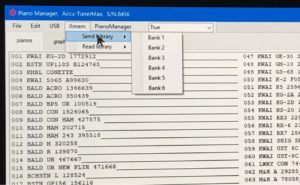This post is preparation for watching the video linked below.
The SAT II’s and III’s need only one file type for memory tunings: .sat
The SAT IV has extended memory and therefore uses two file ‘types’ for memory tuning storage: .sat & .lib
The SAT IV’s extended memory uses library (.lib) files.
The SAT IV’s memory has been expanded to more than double that of the SAT III.
The ‘lower’ memory (Pgs. 1 – 140) in the SAT IV Standard model and the “980”, still use the .sat file type format, but the extended memory, pages (Pgs. 141- 980) use the .lib file type.
SAT IV “Standard Model”: .sat file for the first 140 pages, .lib files for pages 310 – 589.
SAT “980”: .sat file for the first 140 pages, and .lib files for pages 141-980.
In a SAT IV, the memory is organized into ‘Banks’ of pages. Each ‘Bank’ contains 140 pages.
The SAT “980” has a single .sat bank of 140 pages which is lower memory.
The Extended memory, Pages 141 – 980 consists of 6 individual banks of tunings, with each bank containing 140 pages each. Each ‘Bank’ of 140 pages of the extended memory uses .lib file types..
The memory of both Standard SAT IV and the SAT IV “980” works the same, there are just fewer ‘banks’ in the standard SAT IV.
The Standard SAT IV, contains a protected memory area that contains Inventronics Generics Pre-Stored Memory Tunings. These Inventronics tunings are protected and cannot be changed, erased, or modified. They can however be copied into the lower memory for various applications of SAT IV features.
{These same Inventronics tunings can also come pre-stored in a SAT “980” if desired. But with the “980” they are stored on pages in the Extended Memory that is available for us to use and not protected by the SAT’s program. Those Inventronics Tunings can therefore be organized differently, or modified to suit the needs and wants and uses of the SAT Technician. They can also be erased or written over to make room for other tunings.}
In the Standard Model SAT IV’s pages 310 – 589 is two banks of 140 pages each – two .lib files – one for bank 310 – 449 and another for bank 450 – 389.
Working with .LIB and .SAT files in Piano Manager for both SAT IV models is exactly the same.
Once the SAT has been plugged into the computer and Piano Manager has been opened, Piano Manager recognizes which model (Standard or 980) SAT is plugged in to the computer.
When clicking the Xmem button, the send and read choices and then the number of banks with their pages 310 – 449, and pages 450 – 589 will appear in Piano Manager.
(Since I don’t have a standard model SAT IV, I can’t show a picture of what that looks like. But it’s just like the picture below, only with different bank information. If yours is a Standard Model, you will see the two options, one for pages 310 – 449, and one for pages 450 – 589).).
With a SAT “980” instead of the 2 banks with their pages 310 – 449 and 450 – 589, Piano Manager shows the 6 banks, named Bank 1, Bank 2, Bank 3 and so on.
With either Standard or “980” each bank must be dealt with individually in Piano Manager.
Here is what Piano Manager’s Xmem tab shows when connected to a SAT “980”:
(Click to Enlarge)
Of course, after the banks and pages of tunings have been installed into either model SAT IV, scrolling up thru the pages in the extended memory is seamless, the SAT reads the banks as if it was all one file.
This 25 minute video will show how to use and work with Library files in Piano Manager for storing and retrieving tunings in the Extended memory of the SAT IV.
Some of the basic differences between a .sat file and a .lib file will be explained.
Also shown in this video is how to move a single tuning or a group of tunings from one tuning file to another. Tunings can be moved from a .SAT file to a .LIB file and vice versa.
Click Here to Download Piano Manager, Piano Librarian, and Instruction Manuals

